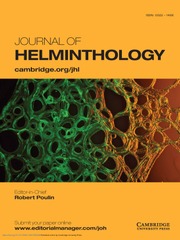No CrossRef data available.
Article contents
Aprocta bainae sp. nov. (Spirurida: Aproctidae) from a flammulated owl in the USA
Published online by Cambridge University Press: 01 August 2025
Abstract
Aprocta bainae Mutafchiev & Kinsella sp. nov, collected from the orbits of a flammulated owl, Psiloscops flammeolus (Kaup) (Strigiformes: Strigidae), from Montana, USA is described based on light and scanning electron microscopies. Additionally, fragments of 18S and 12S rRNA genes of the new species are provided. Based on the molecular data of the 18S gene, A. bainae n. sp. was included in a monophyletic clade of the genus Aprocta. Aprocta ophthalmophaga Stossich, 1902 and Aprocta colaptidis Schuurmans-Stekhoven, 1950 are considered species inquirendae. Aprocta colaptidis Schuurmans-Stekhoven, 1951, a homonym of A. colaptidis Schuurmans-Stekhoven, 1950, is considered a species incertae sedis.
Information
- Type
- Research Paper
- Information
- Copyright
- © The Author(s), 2025. Published by Cambridge University Press

